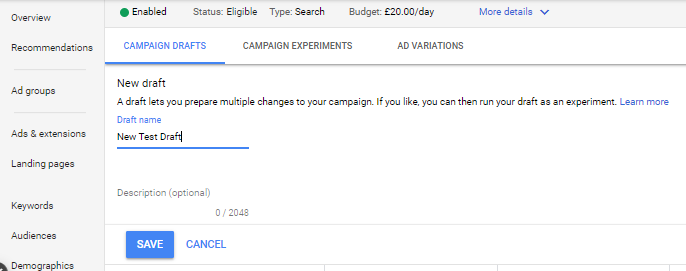Companies have been using A/B split testing to test different digital advertising approaches since time immemorial. But it’s only recently that Google, our beloved master, has decided to incorporate the procedure into its PPC tool, finally giving users the ability to test different Adword campaigns for their efficacy scientifically.
The basic idea behind “Adwords Campaign Experiments” (abbreviated ACE) is to recreate the A/B testing model. Google has given Adwords users the ability to adjust one element of their campaign at a time and split customers at random into two funnels, one that experiences the original piece of advertising, and one that gets exposed to the slightly adjusted version. The hope is that company managers and marketing experts can then use the information from the two streams of users and then select the best advertising, based on any statistical discrepancy between the two.
In this article, we’re going to take a look at what ACEs are, what you can test with them, how to set them up, and measuring your results.
What Can You Test With ACE?
As always, the concept is simple, but the execution is not. According to Google, Adwords users can test three broad categories with ACE: bids, placements and keywords.
The keyword bid experiment tools allow you to split test bid changes for particular keywords. So, in effect, you don’t make any changes to the content of your advertising at all: you just alter the amount that you’re willing to pay for a particular keyword for some users and then track whether paying a different amount of money leads to an outcome that you want. You might find, for instance, that it’s worth spending a little extra for some keywords compared to others because it nets you a higher conversion ratio overall.
Another feature is keyword expansion and reduction. Google included this tool to help people experiment with longtail keywords. Sometimes it’s not entirely clear whether a company should target a five-word or a four-word version of a particular long-tail keyword. With ACE, Adwords users can now split searchers into two groups at random and test which variety offers the best results.
You can also test different match types and ad group structures to see which perform better in the real world. So Google allows users to check their campaigns through ACE in practically every dimension imaginable, giving users genuine freedom.
What Should You Test With ACE?
There’s a big difference between what you CAN test with ACE, and what you SHOULD test. ACE, like so many Google tools, provides enormous flexibility to do just about anything you want. But the real skill is in working out what needs to be tested and probed, and what doesn’t. It doesn’t make sense examining every last facet of your Adwords campaign – that would be a colossal waste of time. You want to focus on testing things that are likely to have a high impact. But how?
Look At Your Campaign Quality Score
If your campaign quality score is low, then you can use ACE to trial new keywords and see if it helps your campaign fare any better.
You Have Good Cost-Per-Action But Little Traffic
Excellent CPA and low traffic might be a feature of your industry or business. But does it have to be? Possibly not. If you have good CPA but low traffic, it would be a problem with your choice of keywords: you’re attracting a segment of the market that is interested in what you’re doing, but you may be missing out on a whole group of people who are using different keyword search terms. ACE allows you to test a bunch of new keywords and find out whether you’re missing a trick.
How Do You Set Up Adwords Campaign Experiments?
So, we’ve described what ACE is and when you should use it, but how do you go about setting it up?
Google has a helpful help document that goes through the whole process in detail, but we’ll cover the basics here so that you’re ready to carry out your first experiment.
Step 1: Access Experiment Settings
The first thing to do is to tell Adwords that you’d like to start dedicating some of your impressions to experimentation. Go to the Campaign tab and then to Settings. Scroll down until you hit the bottom of the tab where you’ll see a button labelled “Specify experiment settings.”
Click this button, and you’ll be presented with another menu screen which takes you through step-by-step, how to set up your experiment. The menu will give you a choice for how to split your customers, with the default being 50 per cent control, 50 per cent experiment. If you don’t want to risk too many of your customers on an experimental setting, you can adjust the size of the experiment group downwards.

Step 2: Run The Experiment
The next step is to run the experiment for a given period. But before the trial can become active, you need to tell Adwords which keywords you’d like to stay the same and which you’d want to change. You can put as many keywords as you like in the experimental group, but remember, the more changes you make, the harder it is to figure out which changes are having the desired effect (if any).
Go to the keywords tab and then select the control and experiment tab next to each keyword. This allows you to assign the keyword to one of the two experimental groups.
Step 3: Save Your Keyword Choices
The final step is to save your Adwords Campaign Drafts as the experimental keywords that you’d like to use and save. Make the experiment live and then see what happens. You should get the information you need to improve your Adwords campaigns and better target your audience, all while spending less money overall.
Summary
Google Ads campaign experiments is a very effective tool for testing different strategies. It reduces risk by allowing you test a % of traffic against the original control. Using campaign experiments helps you be sure you are following the best possible approach, while also improving your ability with Google Ads.












